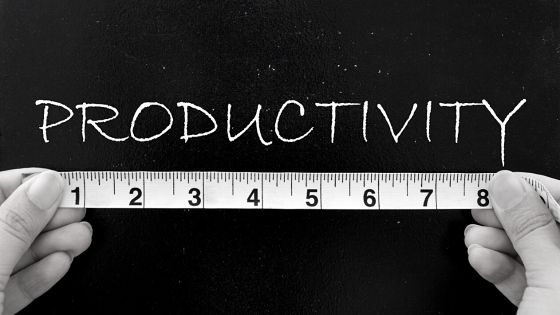Productivity is an essential component of a flourishing workplace, one that promotes contentment and success for both employees and business owners alike. The advantages of a genuinely productive work environment extend far beyond maximising output. They encompass increased job satisfaction, improved motivation, superior time management, and heightened quality of work.

Productivity is not merely a matter of performing tasks with haste in order to maximize output; rather, it is the ability to deliver high-quality work with ease and satisfaction, in a timely manner, that is of the utmost importance.
You’re probably familiar with the all-too-common productivity tips that do the rounds on social media, but here are some insider tips from our workplace optimisation consultant you may never have thought of.
Tip 1 – Comfort Is Crucial
Maximise comfort for maximum performance.
Comfort plays a significant role in productivity. When you are comfortable, you feel more relaxed, focused, and motivated. This leads to increased productivity and better performance in many areas of your life, including work, school, and personal projects.
Most people think ergonomics is all about making sure your screen is at the correct height, your chair is adjustable, and the phone is not too far out of reach. However, good ergonomics is really about maximizing comfort whilst keeping you safe and supported in your work environment. Every ‘body’ is different, so it goes without saying that everyone’s preferences for the way they work and what feels comfortable for them will be different too.
Ensuring your workspace it set up correctly goes far beyond following a generic ergonomic checklist. Workplace optimisation and ergonomic specialists are able to assess, update and advise how best to set up and use your workspace to suit your individual needs, maximise comfort and improve your productivity.
Here are some ways in which comfort assists in improving productivity:
-
Stress reduction
Comfortable surroundings can help reduce your stress levels, which can make it easier to focus and concentrate on important tasks. When people are stressed and uncomfortable, they may find it difficult to work efficiently and effectively.
-
Enhanced focus
When you are comfortable, you tend to be less distracted and more focused on the task at hand. This can help you stay on track and avoid annoying distractions that can decrease productivity.
-
Boosting mood
Comfortable surroundings can improve your overall mood and morale, making you more motivated to work and achieve your goals. The happier you are, the more productive you are leading to increased task and job satisfaction.
-
Promoting creativity
Comfort can also promote and improve your creativity and innovation. When you are relaxed and comfortable, you are more likely to come up with new and innovative ideas.
Ensuring your workspace is set up for maximum comfort can play a crucial role in promoting productivity. By working in comfortable surroundings, you can reduce stress levels, enhance focus, boost morale, and promote creativity, all of which can lead to increased productivity and better performance.
Tip 2 – Brown Noise
Brown noise reduces distractions and maintains focus.
Brown noise is a type of sound that is different to white noise. Brown noise is a deeper, lower-frequency tone and when your brain is exposed to brown noise, the electrical activity can be affected, leading to changes in brain wave patterns.
Brown noise has been shown to increase alpha and theta brain waves, which are associated with relaxation and creativity. These brain wave patterns are typically seen during periods of relaxation, and they can help promote a sense of calm and mental clarity.
Here are some ways in which brown noise can boost productivity:
-
Reduces distractions
Brown noise can help block out background noises that can be distracting and interfere with concentration and productivity. By creating a more peaceful and quieter environment, you may find it easier to focus on your work and finish your tasks faster.
-
Enhances focus
Brown noise can also help enhance focus and concentration. The steady, low-frequency sound can create a calming effect that can help people stay on task and avoid distractions. By stimulating alpha and theta brainwaves your ability to think clearly is also enhanced.
-
Reduces stress
Brown noise has been shown to have a calming effect on the brain and body, which can help reduce stress levels. When you are less stressed, you will find it easier to concentrate and be more productive.
-
Improves sleep quality
Brown noise has been shown to help improve sleep quality, which can lead to better productivity during the day. By cultivating a more restful night’s sleep, you will feel more energised and focused during the day.
Listening to brown noise can be a useful tool in promoting productivity. By reducing distractions, enhancing focus, reducing stress, and improving sleep quality, brown noise can help you be more productive and efficient while working.
Tip 3 – Walking While Working
Walking releases chemicals in your brain improving mood, memory & learning.
Treadmill desks are popping up all over the place, and for good reason. Once seen as a gimmick and something to be laughed at, has now been shown to have multiple benefits that extend beyond the workplace. Movement during the day, especially aerobic activity like walking, has been shown to positively affect mood, energy levels, productivity and even help with overall health and weight management.
Here are some ways in which walking and working can assist in boosting productivity:
-
Increased blood flow
Walking increases oxygenation and blood flow to the brain, which can improve cognitive function and mental clarity. This leads to improved focus and productivity.
-
Learning and creative thinking
Walking stimulates the release of brain-derived neurotrophic factor (BDNF), which is a protein responsible for brain cell survival, repair, and growth. Increased BDNF in the brain is essential for memory and learning. Increasing levels of BDNF can help refresh the mind and encourage new perspectives, creative thinking and problem-solving.
-
Reduced pain and stress
Walking can also help reduce pain and stress levels by releasing endorphins in your brain. Endorphins are natural mood boosters, painkillers and stress relievers. The release of endorphins leads to improved focus, comfort, and productivity.
-
Improved mood
Walking releases serotonin in your brain which is responsible for keeping you alert and promoting happiness. This boost in serotonin can improve your mood, and happiness levels and have a positive effect on productivity.
-
Increased energy and better posture
Walking helps increase energy levels and reduces fatigue. Walking helps to negate the negative effects of sitting and increases oxygen levels and blood flow to your brain which all improve productivity and focus.
-
Weight management and improved overall health
Walking during the day is a simple and effective way of increasing your step count and activity levels. The benefits of physical activity are well documented and include reduced risk of cardiovascular disease, obesity, and cognitive impairment.
There are several ways to incorporate walking into work. One way is to use a treadmill desk, which allows you to walk while working on a computer or performing other tasks. Another way is to take walking breaks throughout the day, whether it’s walking outside, in a hallway, or around the office. Incorporating walking into your work can be a great way to improve productivity, focus, and overall well-being.
So remember, productivity is not solely about completing tasks quickly but more about delivering high-quality work with ease, satisfaction and in a timely manner. The three insider tips discussed in this post—maximising comfort, listening to brown noise, and walking while working—can play a crucial role in creating a productive and fulfilling workspace.
By creating a comfortable workspace, reducing distractions, enhancing focus, reducing stress, and promoting creativity, you can be more productive and efficient while you work. Remember that every “body” is different, so what works best for you might not work for someone else. Therefore, it’s important to try out different methods to see which ones work best for you.



















